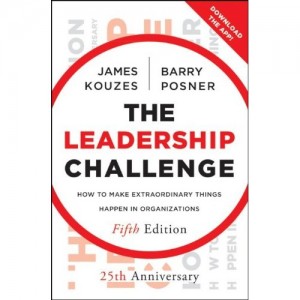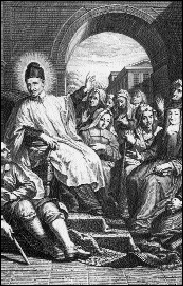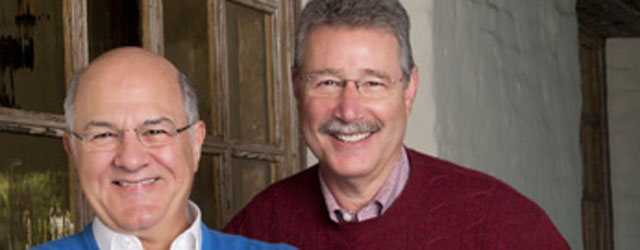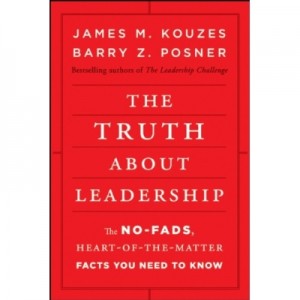Vincent, James Kouzes and Barry Posner:
Time-Tested Leadership Truths
Introduction
Here at Vincent on Leadership: The Hay Project and the School of Public Service at DePaul University, we often use the research and insights of James M. Kouzes and Barry Z. Posner in our leadership courses and training workshops. Together, Kouzes and Posner have authored more than a dozen books on leadership and leadership development, including The Leadership Challenge and, The Truth About Leadership. They also developed the Leadership Practices Inventory (LPI), an assessment tool based on their Five Practices of Exemplary Leadership™.
Dr. J. Patrick Murphy, C.M., professor in DePaul’s School of Public Service, recently facilitated a conversation about the book, The Truth About Leadership. He said what he found most significant in this latest offering by Kouzes and Posner is their observation that there is nothing new about leadership. However, what has changed over recent decades and what is new is the context.
The changes in context mentioned by Kouzes and Posner include global concerns, such as terrorism, climate change, and scarcity of resources. More local changes include a workforce that is “becoming increasingly diverse, multicultural, dispersed, horizontal, and distributed – and, consequently, requiring more collaboration than competition”(2010.xiv)
Meanwhile, most of the content of leadership has not changed. As Kouzes and Posner put it, “The fundamental behaviors, actions and practices of leadership have remained essentially the same since we first began researching and writing about leadership over three decades ago” (xv).
As Vincentians, we realized we could look even further back than Kouzes and Posner to Vincent de Paul, who founded and led organizations nearly 400 years ago, to find evidence of the timelessness of the 10 leadership truths. Vincent illustrates them in his own leadership behaviors, actions and practices. In this post, we compare Vincent’s leadership with the research done by Kouzes and Posner. To do this, we first need to look at a brief summary of the 10 truths as presented by Kouzes and Posner.
Kouzes and Posner suggest there are ten “fundamental truths about leadership and becoming an effective leaders (xxi). They explore each of these truths in depth drawing on examples from their research. The ten truths are:
1. You Make a Difference
2. Credibility Is the Foundation of Leadership
3. Values Drive Commitment
4. Focusing on the Future Sets Leaders Apart
5. You Can’t Do It Alone
6. Trust Rules
7. Challenge Is the Crucible for Greatness
8. You Either Lead by Example or You Don’t Lead at All
9. The Best Leaders Are the Best Learners
10. Leadership Is an Affair of the Heart
What follows is a summary of the major points made by Kouzes and Posner on these ten truths about leadership, along with observations on them made by Dr. J. Patrick Murphy, C.M., in a recent presentation to DePaul University students and staff. This is followed by a look at Vincent de Paul and how he exemplified each truth in his own life.
1. You Make a Difference
According to Kouzes and Posner the first truth of leadership is a recognition that making a difference as a leader begins with leading yourself. You make the difference, by modeling the way. You cannot do that effectively until you take the time to know yourself, what motivates you, what holds you back.They write: “Before you can lead others, you have to lead yourself and believe that you can have a positive impact on others”(1).
2. Credibility is the Foundation of Leadership
Drawing on interviews with leaders on every continent, Kouzes and Posner have identified the top four attributes that people most want to see in their leaders:
- honest
- forward-looking
- inspiring
- competent.
What ties all of these together, in their view, is credibility. They created a simple acronym for measuring credibility. It is DWYSYWD and stand for: “Do what you say you will do.”
3. Values Drive Commitment
Kouzes and Posner explain the connection between values and commitment with this simple advice: “You can’t fully commit to something that doesn’t fit with who you are and how you see yourself” (31).
Leadership, then, begins with listening to your inner self; learning in the process what it is you most value. As a leader, you cannot commit to organizational values that are not consistent with your own, and it will show in your leadership. “[M]aking sure that your values and the organization’s values are aligned is essential to maintaining your integrity” (38)
Leadership, though, is also about inspiring a commitment to common values from everyone in the organization. How do you do that? Dr. Murphy summarized it this way in his presentation: “People want to know your values and beliefs. They want to know:
- What do you care about?
- What drives you?
- What makes you happy?
- What makes you tick?
- What ticks you off?
- What is your story?”
“Becoming a leader begins when you come to understand who you are, what you care about, and why you do what you do. This is a journey all leaders must take,” added Dr. Murphy.
4. Focusing on the Future Sets Leaders Apart
Kouzes and Posner note that the quality of being forward-looking came in second only to being honest when they surveyed thousands of people on what they want in their leaders. “The capacity to imagine and articulate exciting future opportunities is the defining competence of leaders” (46). People depend on their leaders to offer the long-term view, providing direction and meaning that transcends the day-to-day details of work and life.
5. You Can’t Do It Alone
Speaking in contemporary terms, Kouzes and Posner put the emphasis on collaboration this way: “No matter how capable a leader is, he or she alone won’t be able to deliver a large project or program without the joint efforts and synergies that come from the team” (62).
But, there is more to it, say Kouzes and Posner, than just assuming the role of leader and asking others to lend a hand. “Leadership is about the relationship between leaders and their constituents…it’s about the emotional bond that exists between you and them” (63). People need to feel united around a common vision.
6. Trust Rules
Leaders must show that they can be trusted, observe Kouzes and Posner. An increase in trust means an increase in your ability to influence others; loss of trust means you are done as a leader. “Trust rules your personal credibility. Trust rules your ability to get things done. Trust rule’s your team’s cohesiveness…Trust rules just about everything you do” (76).
There are four ways you can show that you can be trusted:
- behave predictably and consistently;
- communicate clearly;
- treat promises seriously;
- and be forthright and candid (84-85).
7. Challenge is the Crucible for Greatness
Kouzes and Posner summarize this truth by acknowledging that all great leadership achievements involve overcoming adversity, difficulty, change, and challenge. “The study of leadership is the study of how men and women guide people through uncertainty, hardship, disruption, transformation, transition, recovery, new beginnings, and other significant challenges” (93).
Facing and meeting challenges helps to clarify one’s vision and reinforce one’s commitment. At the same time, lessons learned through these experiences can be valuable for the future.
8. You Either Lead by Example or You Don’t Lead At All
“Model the Way” is the first of “The Five Exemplary Leadership Practices™ identified by Kouzes and Posner from their leadership research. In The Truth About Leadership, they explore further this important aspect of leadership. They write:
“You have to model the way you want others to feel, think, and act. You have to show others that you are going to do exactly what you are asking them to do” (106)
For the people you hope to lead, the old adage, “Seeing is believing,” is critical.
“When people see you doing what you say, then they have the evidence that you mean it. Otherwise it’s just words. Your actions send the loudest signals about what other people should be doing” (110).
Modeling the way also involves admitting your mistakes. When you do as the leader, say Kouzes and Posner, you help create an environment in which others will do the same, helping the organization to learn important lessons in the process.
9. The Best Leaders are the Best Learners
Dr. Murphy summarized the comments by Kouzes and Posner on the leader as learner: “Leadership can be learned. It is an observable pattern of practices and behaviors, and a definable set of skills and abilities. The problem? Not everyone learns it; and not all master it.”
Deliberate, measured practice to acquire new skills, and the support of others on your leadership development journey also are essential requirements.
10. Leadership Is an Affair of the Heart
“Love” is a word not often heard in the corporate world today, but Kouzes and Posner use it liberally in their chapter on leadership as “an affair of the heart.”
“Love enlarges lives. Love creates the desire to serve others and to see them grow and become their best,” write Kouzes and Posner (139).
How as leaders do we do this? Dr. Murphy summarized the insights offered by Kouzes and Posner on how leaders can express love to their follows: “Show them that you care. Pay attention to them. Recognize them. Tell stories about them. Be there with them—in the halls, at lunch, events, and parties.”
Kouzes and Posner also suggest that leaders must love their work to be successful. “Loving leading means that you’re passionate about values and visions that make a difference, that you look forward ever day to devoting your time to strengthening others and building teams, that you relish the chance to tackle a daunting challenge and search for new possibilities, and that you truly enjoy recognizing others for their contributions to the success of the enterprise” (147).
Vincent and the 10 Truths
Kouzes and Posner suggest that there is nothing new about leadership these days, only the context has changed. As Vincentians, we wondered if we could look even further back than the last few decades of research by Kouzes and Posner to Vincent de Paul. He founded and led organizations nearly 400 years ago. Is there evidence in his life of the 10 leadership truths identified by Kouzes and Posner? Let’s take a look now at some examples from Vincent’s leadership practices, teachings and behaviors in light of the 10 truths.
There is not question that truth No. 1, “You make a difference,” is evident in Vincent’s life. Vincentians are well aware of the dramatic difference that Vincent de Paul made during his lifetime in 17th Century France. His biographers calculate that the numbers of women, men, and children offered assistance through the organizations Vincent inspired with his leadership number in the hundreds of thousands. “Vincent made a difference with his life. That difference lives on 350 years after his death,” commented Dr. Murphy.
Vincent knew about credibility as a leadership truth. He often said key to that credibility is communication. He wrote: “This means giving a straightforward opinion about things in the way we honestly see them, without needless reservations. It also means doing things without any double-dealing or manipulation.” He recommended: “When questioned, be prepared to answer as follows: ‘I’m of such an opinion for such and such reasons.'”
Vincent was values-driven. He discovered his life-long mission of charity to the poor in the events of Aug. 20, 1617, at Châtillon-les-Dombes. Vincent served in the small, French town as parish priest. On that Sunday morning, Vincent heard about a family in great need living on the outskirts of the village. He preached about the family’s need at Mass that morning, and then set out to visit them.
As the story goes, along the way he discovered that is sharing his own concern and the story of this family during the Mass, he had inspired a veritable procession of people from the parish, all carrying food to the hungry family. Vincent reacted by saying, “There is great charity, but it is badly organized.” In the following days, Vincent worked with the local villagers to organize a sustained charitable effort, for not only this first family, but others as well.
But Vincent didn’t stop there. As Kouzes and Posner point out, he was focused on the future. After viewing the outpouring of charitable response to the poor family at Châtillon, Vincent could see a future in which the family would be better off with a plan in place to provide help on a consistent, daily basis. From his vision arose the first group of parish-based women, known as the Confraternity of Charity, which began to offer material and spiritual aid the poor under Vincent’s direction.
The establishment of the Confraternity of Charity at Châtillon was only the beginning of the collaborative efforts that show that Vincent recognized the fifth leadership truth: you can’t do it alone. Eventually, he inspired a world-wide charitable effort. Vincent knew that much more could be accomplished through collaboration than alone.
But there is more to collaboration than just organizing people into a group. “Leaders mentor and teach,” said Dr. Murphy. “They listen as much as they tell.” He noted that Vincent prescribed a participatory, democratic style of organizational structure and dynamics, seeking out and including in his decisions the opinions of the members of his organizations.
Kouzes and Posner strongly emphasize trust as the foundation of successful leadership. By the time he died, Vincent had earned the trust and confidence of most of the Church and society of Europe. His popularity was so strong the people of France called him, “Father of our Country.”
Vincent de Paul faced many challenges in his life. As Dr. Murphy noted, “Vincent begged at the court of France. Vincent was a master negotiator, often caught in delicate political situations. Vincent ran a transportation company, a farm and a vineyard in his spare time.”
For Vincentians today, the challenge is to become expert practitioners of the art and science of organizing, just as he did. A second challenge is keeping the organization and its leadership unselfishly committed to the vision. For Vincent, that meant always seeing the service of the poor as God’s work.
For Kouzes and Posner, successful leaders lead by example. Vincent’s many accomplishments point to how he modeled the way for others. He was responsible for an incredible out-pouring of care for people on the edges of society in 17th– Century France. Religious evangelization organized by Vincent transformed the Catholic Church, especially through the formation of priests. Day after day, Vincent managed these activities with integrity, passion, perseverance, and respect for the dignity of each person served that became hallmarks of the organizations he helped to found.
A commitment to learning is key to successful leadership, say Kouzes and Posner. Vincent described himself as a life-long learner, and encouraged it in his followers: “It is not a fault to seek the advice of others. On the contrary, it is helpful, and sometimes even necessary to do so when the matter is important, or when we are not well informed…As for myself, I often ask the brothers, and take their advice in matters pertaining to their work.”
![]() Lastly, Kouzes and Posner say leadership is an “affair of the heart.” Vincent de Paul expressed both of these ideas about love when he said, “Compassion means to suffer with our brothers and sisters, to weep when they weep. Compassion is that manifestation of love which enables us to enter into another’s hearts and feelings.”
Lastly, Kouzes and Posner say leadership is an “affair of the heart.” Vincent de Paul expressed both of these ideas about love when he said, “Compassion means to suffer with our brothers and sisters, to weep when they weep. Compassion is that manifestation of love which enables us to enter into another’s hearts and feelings.”
Reflection Questions
What stories can you tell of how Vincent made difference? How do Vincentians make a difference today?
What do you think helped to make Vincent such a credible leader?
How would you describe the values that drive your Vincentian leadership today?
What was the future that Vincent envisioned for God’s people? What future do you envision?
Who were the primary companions of Vincent on his leadership journey? Who are yours?
In what ways did Vincent inspire trust in his followers? Have you ever done something that jeopardized trust in you as a leader? If so, how did you regain the trust of others?
What helped Vincent to overcome the many challenges he faced in promoting his work on behalf of the poor?
What are some of the ways Vincent continues to “model the way” for you?
How has Vincent inspired you to further develop your leadership?
What are your favorite examples of how Vincent expressed love for those with whom he served and ministered?
References
Kouzes, James M. and Barry Z. Posner, The Truth About Leadership: The No-fads, Heart-of-the-matter Facts You Need To Know. Jossey-Bass. 2010. Used with permission.
Edited by Patricia M. Bombard, BVM, D.Min., Director, Vincent on Leadership: The Hay Project, DePaul University, Chicago, IL USA




